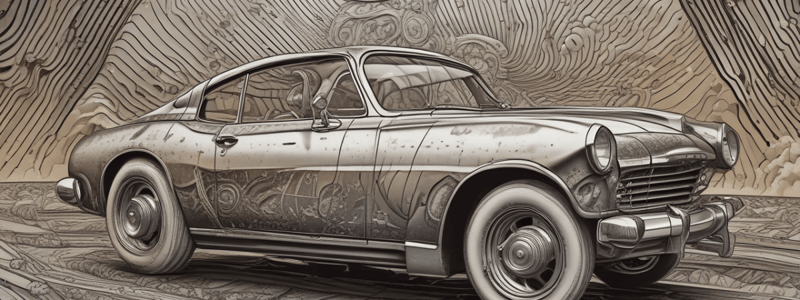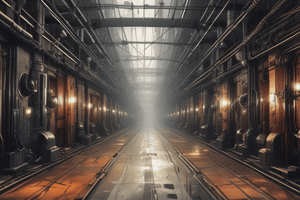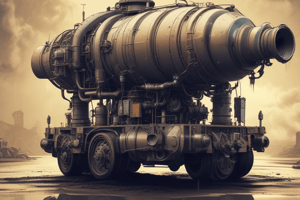Podcast
Questions and Answers
What is the purpose of a spray booth?
What is the purpose of a spray booth?
- To control overspray (correct)
- To reduce compressor noise
- To collect sawdust
- To increase humidity in the workspace
Proper PPE such as Respirator Masks must be worn at all times in a spray booth.
Proper PPE such as Respirator Masks must be worn at all times in a spray booth.
True (A)
What is the purpose of a drip leg in an air system?
What is the purpose of a drip leg in an air system?
drain system of any condensed water
_______ is the process of breaking up bulk liquids into droplets.
_______ is the process of breaking up bulk liquids into droplets.
What are the pros of using a Gravity Feed conventional spray gun?
What are the pros of using a Gravity Feed conventional spray gun?
What are the cons of using a Siphon (Suction) Feed conventional spray gun?
What are the cons of using a Siphon (Suction) Feed conventional spray gun?
What are the primary parts of a Conventional Spray Gun?
What are the primary parts of a Conventional Spray Gun?
HVLP stands for High Volume Low ______
HVLP stands for High Volume Low ______
Airless Spraying requires compressed air for atomization.
Airless Spraying requires compressed air for atomization.
Flashcards are hidden until you start studying
Study Notes
Overview of Spray Finishing and Touch-Ups
- Covers equipment, materials, and techniques for spray finishing
- Divided into two parts: theory and practical
Air Compressors
- Supply clean, dry air to various shop equipment
- Type and size of compressor depend on spray equipment used
- Components:
- Motor and air pump to force air into storage tank
- Storage tank to hold compressed air
- Properties:
- Pressure (typically stated in psi)
- Delivery rate (flow rate) in CFM at a specific pressure
- Storage volume (in gallons or liters)
Humidity and Compressors
- Air holds water vapor (moisture), and humidity is the amount of water vapor in air
- Maximum water vapor air can hold depends on temperature and pressure
- Compressors and water:
- Compressed air cannot hold as much water, so water collects in the storage tank
- When air is released, it expands and cools, causing condensation in air lines
Types of Air Compressors
- Piston type:
- Creates air pressure through reciprocating piston action
- Single stage (one cylinder) or two stage (two cylinders) configurations
- Rotary screw type:
- Uses intermeshing helical rotors in a twin bore case
- Quieter and has a higher CFM than piston type, but more expensive
Compressors and Sawdust
- Sawdust can clog air intake filter, so it's best to feed air from outside the shop
- Compressors create heat, so they are equipped with cooling fins (radiator)
Compressed Air Components
- Filter: removes water or debris from the air system
- Oiler/Lubricator: adds oil mist to air line for tools that require lubrication
The Spray Booth
- Enclosed area with lighting, filters, and an exhaust fan for applying spray finishes
- Reasons to use a spray booth:
- Control overspray
- Reduce contamination of wet finish
- Protect finisher from harmful gases
- Reduce risk of explosion/fire
- Protect environment from airborne products
Types of Spray Booths
- Down draft: draws air from above and directs it out through filters in the floor
- Cross draft/draft through: draws air from one end and out through a filter wall
- Waterfall/waterwash: uses a running sheet of water to absorb overspray and airborne products
Make-Up Air Unit
- Introduces filtered and heated air to compensate for exhausted air from the spray booth
- Prevents negative pressure and cold temperatures in the shop
Air Velocity and Lighting
- Air must move through the booth with sufficient velocity to carry away overspray and toxic vapors
- Measuring and controlling velocity using a manometer
- Proper lighting is essential for applying a finish; lighting must meet explosion-proof requirements
Spray Booth Maintenance and Rules
- Monitor manometer and clean filters when required
- Keep lighting clean and free of overspray
- Keep floors and walls clean of dust and overspray
- Tidy up regularly and dispose of rags properly
- Follow safety rules, including wearing PPE and avoiding smoking and open flames
Spray Systems
- Definitions:
- Overspray: application of a finish onto an unintended location
- Transfer Efficiency (TE): percentage of material that adheres to the substrate
- Basic operating principle: take liquid finish, break it up into small droplets, and propel them toward a workpiece
Creating Droplets and Making Liquid Flow
- Atomization: breaking up bulk liquids into droplets
- Means of making liquid flow:
- Gravity
- Suction
- Pressurized container
- Pump
Types of Spray Systems
- Conventional spray guns:
- Gravity feed
- Siphon (suction) feed
- Pressure pot system
- HVLP (High Volume Low Pressure) turbine system
- Airless spraying
- Air-assisted airless spraying
- 3M Paint Preparation System (PPS)
Controlling Sheen with Flattening Agent
- Solid particles stirred into a finish to reduce sheen
- Particles create micro-roughness on surface, scattering light randomly
- Most finishes available with flattening agent included
Troubleshooting
- Air cap orientation affects spray pattern shape
- Spray patterns are a function of air flow setting and fluid (material) setting### Troubleshooting Spray Gun Issues
- Rotating air cap 180 degrees to diagnose issues: if defect rotates, the issue is with the air cap; if it doesn't rotate, the issue is with the fluid tip or needle.
- Importance of even coverage: moving the gun parallel to the workpiece ensures even coverage; rotating the gun can cause uneven coverage.
Common Issues with Spray Guns
- Pulsating or fluttering finish: caused by tipping the gun too far, blocking the vent hole, and preventing air from entering the cup; resolve by cleaning the vent hole.
Respiratory Protection
- Importance of respirators: protect against particulate hazards and chemical gasses.
- Factors to consider when selecting a respirator: type of hazard, level of exposure.
Respiratory Equipment Types
- Negative Pressure: relies on the wearer's lungs to pull air through the cartridge or filter; requires fit testing, seal checks, and can be affected by facial hair.
- Positive Pressure: equipment pushes air to the hood or facepiece; can be powered air or supplied air, and may be loose or tight fitting.
Self Contained Breathing Apparatus (SCBA)
- Definition: user carries the source of clean air with them in a tank.
- Key characteristics: provides a self-contained source of clean air, independent of the surrounding environment.
Filter vs. Cartridge
- Filters: remove particles from the air.
- Cartridges: remove chemical gasses from the air; some cartridges also include a filter.
Choosing a Filter
- Letter meaning: N-Class filters are not resistant to oil, R-Class filters are oil-resistant, and P-Class filters are oil-proof.
- Number meaning: '95' filters out at least 95% of airborne particles, '99' filters out at least 99%, and '100' filters out at least 99.97%.
Choosing a Cartridge
- Colour-coded label: black for organic vapors, white for acid gasses, yellow for both, and green for ammonia or methylamine.
Maintenance and Replacement
- When to change a cartridge or filter: when it's clogged, when the established time of usage elapses, or when you smell or taste the contaminate.
Studying That Suits You
Use AI to generate personalized quizzes and flashcards to suit your learning preferences.



